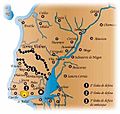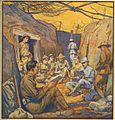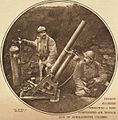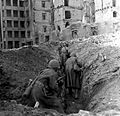Trench warfare facts for kids
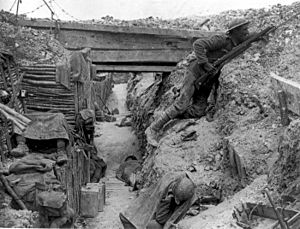
Trench warfare is a way of fighting a war. It was used a lot in the First World War. This happened on both the Eastern Front and the Western Front.
In trench warfare, both sides dig long, narrow ditches called trenches. These trenches have different parts. They include places for soldiers to sleep, command centers, and spots for artillery and machine guns.
Between the two sides' trenches was an area called "no man's land". This area was often covered with barbed wire and hidden land mines. Soldiers would try to cross this dangerous land to attack the enemy's trench. Tanks were sometimes used to help cross this area.
Trench warfare was used because it gave soldiers protection. They could defend themselves from attacks while staying hidden. Trenches also offered places for soldiers to rest. However, these resting spots were often dirty and uncomfortable.
World War I lasted from 1914 to 1918. Soldiers needed ways to protect themselves. So, they dug deep holes, about two meters (six feet) deep. These holes became the trenches where they fought. The trenches were sometimes very close, even as short as thirty meters apart. The open space between them was called "No Man's Land." Death was common, even without fighting, often from diseases. This style of fighting was known as trench warfare.
Contents
Life in the Trenches: Challenges and Conditions
Life in the trenches was very hard. The trenches were often dirty and full of dangers. Many diseases spread quickly among the soldiers.
Health Problems: Diseases and Pests
One common disease was "trench foot". This was a fungal infection that could rot a person's feet. It happened because of the cold, wet, and unclean conditions. Another problem was lice. These tiny insects caused a disease called trench fever. It led to severe headaches and high fevers.
Rats were also a big problem in the trenches. Brown rats were especially bad. They spread diseases and ate human remains. These rats could grow as big as cats. The mud in the trenches was very thick. Sometimes, men would even disappear into the deep mud.
The trenches smelled terrible. This was due to many things. Soldiers rarely bathed, and there were dead bodies nearby. Toilets often overflowed, adding to the awful smell. Chemicals like creosol were used to fight disease. All these things combined to create a very strong, unpleasant smell. New soldiers found the smell overwhelming at first. But after a while, they got used to it and became part of the smell themselves.
How Trenches Were Built: The Trench System
Trenches were carefully built to protect soldiers. They had specific designs to make them safer and more effective.
Trench Design and Protection
Front-line trenches were usually about seven feet deep and six feet wide. The front wall of the trench was called the parapet. The top two or three feet of the parapet had thick sandbags. These sandbags helped stop bullets and shell fragments. The back wall of the trench was called the parados. It also had sandbags for protection.
Soldiers could not see over the top of a trench this deep. So, a two or three-foot ledge was added. This was called a fire-step. It allowed soldiers to stand and shoot over the top. Trenches were not dug in straight lines. Instead, they were built with zig-zags. This was important. If enemies got into one part of the trench, they could not shoot straight down the entire line. Each trench had alternating fire-bays and traverses.
Safety Features and Support Trenches
Duck-boards were wooden planks placed at the bottom of the trenches. They helped protect soldiers from the mud and water. This prevented problems like trench foot. Soldiers also dug small shelters into the sides of the trenches. These were called dugouts or funk holes. They offered some protection from bad weather and enemy fire.
The front-line trenches were also protected by barbed-wire fences. Machine-gun posts were set up to defend against attacks. Short trenches called saps were dug from the front-line into No-Man's Land. The end of these saps, about 30 yards forward, were used as listening posts. Soldiers would listen for enemy movements there.
Behind the front-line trenches were support and reserve trenches. These three rows of trenches covered a large area, between 200 and 500 yards of ground. Communication trenches were also dug. They ran at an angle to the front-line trench. These were used to move soldiers, equipment, and food supplies safely.
Images for kids
-
Ottoman soldiers in a trench during World War I.
-
Trenches at the Siege of Vicksburg 1863
-
The Boer trench at the Battle of Magersfontein contributed to the surprise defeat of the Highland Brigade on 11 December 1899 during the Second Boer War.
-
German forward detachments guarding the entrance to a trench line in front of Arras in 1915
-
1st Lancashire Fusiliers, in communication trench near Beaumont Hamel, Somme, 1916. Photo by Ernest Brooks.
-
A surviving trench at Verdun in 2009
-
German trenches in Vimy
-
French troopers using periscope, 1915
-
Soviet soldiers running through the ruins of Stalingrad, 1942.
-
Afghan and U.S. soldiers provide security while standing behind a blast wall made from HESCO bastions at Zhari district, Kandahar Province, Afghanistan, 2012.
See also
 In Spanish: Guerra de trincheras para niños
In Spanish: Guerra de trincheras para niños



